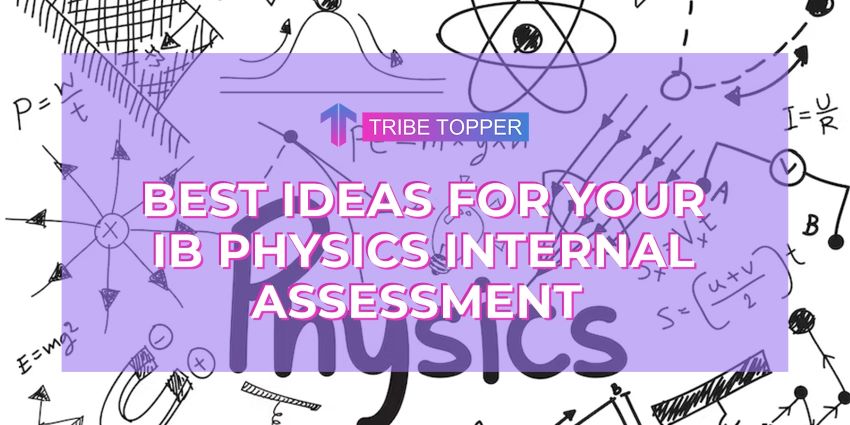
The International Baccalaureate (IB) Physics Internal Assessment (IA) is of utmost significance because it is an integral part of the IB Diploma Programme. The IA allows students to demonstrate their comprehension of fundamental physics ideas while enhancing crucial investigative and analytical skills. It covers a wide range of scientific principles to learn with IBDP Past Paper.
Your IB Physics Internal Assessment objective is to plan and carry out a study that demonstrates both your knowledge of the topic and your capacity to apply physics ideas to practical situations. Here are three fantastic ideas for your internal assessment with IBDP Physics Mock Paper, each with a full explanation:
Idea 1: Examining the connection between period and pendulum length
The pendulum is an intriguing object that exhibits simple harmonic motion (SHM). In this examination, the relationship between a pendulum’s length and period—the amount of time it takes to complete one oscillation—will be examined.
The period of oscillation will lengthen as the pendulum’s length does, according to the theory.
Methodology:
Using a string or rod to create a basic pendulum, hang a tiny mass (such as a bob) from a fixed location.
Keep track of the initial angle (); the pendulum is always displaced from vertical (for example, 10 degrees).
Calculate the duration (T) for 10 full pendulum oscillations at various pendulum lengths (L) using a stopwatch or a motion sensor.
Repeat the measurements for a minimum of five distinct lengths, such as 20, 40, 60, 80, and 100 cm.
For each pendulum length, get the average period (T_avg).
Data analysis:
Plot a graph of the pendulum’s length (L) versus its typical period (T_avg).
By inspecting the graph, determine whether the relationship between L and T_avg is linear or non-linear.
Using the equation g = (42L) / T_avg2, determine the slope of the graph, which reflects the gravitational acceleration (g) if a linear relationship exists.
Discussion:
Talk about the precision and dependability of your findings, considering any potential error causes (such as air resistance or reaction time). Explain any differences between your experimental value of g and the reference value (9.81 m/s2), if there are any.
Idea 2: Examining the Elements That Affect Projectile Motion
The movement of an object in a two-dimensional plane while being affected by gravity is known as projectile motion. This study aims to investigate the variables influencing the projectile range.
The projectile’s initial velocity and launch angle should directly impact its range.
Methodology: Setting up a ramp to act as an incline is a methodology.
With the same initial velocity (v0), launch a ball at various angles using a projectile launcher.
Record the projectile’s horizontal range (distance covered) for each launch angle.
Repeat the measurements for at least five different launch angles, such as 15, 30, 45, 60, and 75 degrees.
Adjust the launcher to maintain the same launch velocity during all experiments.
Data analysis: Draw a graph that contrasts the launch angle () with the range (horizontal distance).
Determine the relationship between the launch angle and the range by analyzing the graph.
Utilizing the ideal launch angle, determine the greatest range (R_max) for the specified beginning velocity (v0).
Discussion: Go over how your findings confirm or disprove your hypothesis. Think about how the projectile launcher’s restrictions and air resistance will affect the precision of your measurements.
Idea 3: Examining Solar Cell Efficiency at Various Light Intensities
Solar cells are machinery that transforms light energy into electric power. This experiment aims to examine solar cell efficiency at varied light intensities.
Theoretically, solar cell efficiency will rise with increasing light intensity up to a certain point, when it will plateau or fall because of heat dissipation.
Methodology: Collect a number of the same solar cells.
To measure the light hitting the solar cells, set up a light source and a light intensity sensor (for example, using a light meter).
Connect the device to a multimeter to measure the voltage and current generated by each solar cell.
To alter the amount of light landing on the solar cells, position them at various distances from the light source.
Keep track of each solar cell’s voltage and current production at various light intensities.
Data analysis: Plot a graph of light intensity versus solar cell efficiency. The following equation can be used to determine efficiency: efficiency = (voltage x current) / soft power.
Examine the graph to see if there is an optimum light level for maximum effectiveness.
Discussion: Based on your findings, discuss the connection between light intensity and solar cell efficiency. Consider elements that could affect the efficiency, such as temperature fluctuations and the caliber of the solar cells, and explain any unexpected trends.
Conclusion: Summarize your results and discuss their importance in your decision. Mention any modifications that might be made to the experimental design or methodology.
Remember that the Internal Assessment Help Service is a chance for you to show off your knowledge of physics, critical thinking, and scientific abilities. Make sure to rigorously document your methods, analyze your data, and present your conclusions clearly and compellingly.

